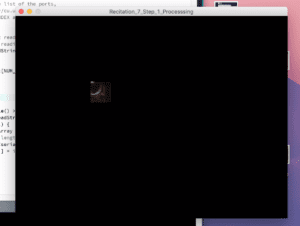Project Title: Truth about Truth
My project is called“Truth about Truth”. This is an interactive art installation that aims to deliver to the audience my thoughts on how a fact is conceived by us, and how difficult it is to be “right”, or to know the whole truth when we are receiving information for those outlets of our choosing. The project will have an image that is blurred or blocked that would only have one spot that is clear when someone actively interacts with it. One image will be on the screen for 15 seconds, and the person interacting with it would have to choose a storyline of what they think is in this image after that. I want to show that our individualized decision-making process is influenced by our different cultural backgrounds, which defines what truth is for us.
During my preparatory research, I found Daniel Rozin’s “Mirror” installations most inspiring. His installations with various objects mirrors the face or shadow of the person in front of it. This way, when there is no observers, his installations do not have meanings. Only the presence of an observer gives his art a meaning. I wanted to make an installation that responses to the viewer’s movement. When someone walks close to the frame, some parts of the image would become clear, and the person’s movement would change the focused area on the canvas. The canvas is black in the beginning, and when someone walks into the frame, there would be a small shape that shows part of the photo. As the viewer moves a magnifier or a flashlight, the shape moves and reveals other parts of the image. With this effect, the viewer can navigate the image and complete it in their brain. The person needs to figure out what they think is in the image and decide in the end. There are no right or wrong answers, but in the end, there will be data gathered to show the result.
General visualization of my project:
The Hong Kong protests happening this year has pushed me to think about the relationship between media and our beliefs. It seems like everyone is taking a side on this issue. The news on Weibo and the news on twitter display completely opposite sides of the violence in Hong Kong. As someone who is sandwiched in between Chinese identity and Western ideologies, I found it quite difficult to choose one extreme on this spectrum. Yet, I am not completely unbiased. For this project, I was inspired by the ideas of “selective exposure” and “third-person effect”. Selective exposure is: “individuals’ tendency to isolate themselves by selecting only attitude-consistent news”(Knobloch-Westerwick and Johnson, 2014). It is based on Festinger’s “cognitive dissonance theory”, which means:“people have an inner need to ensure that their beliefs and behaviors are consistent. Inconsistent or conflicting beliefs lead to disharmony, which people strive to avoid”(Cherry, 2019). Third-person effect means that: “Each individual reasons: I will not be influenced, but they (the third persons) may well be persuaded”(Davison, 1983). I hope the completion of my project could reflect on these theories and remind us that maybe it is better if we can accept the existence of the other side of the rhetoric. Instead of rejecting them or judging them, think about why this rhetoric exists and why there are divided opinions on it. Recently I watched a documentary called “Of Fathers and Sons”. This documentary shows the story of a radical Islamist family, a group of people we would not read about from the news we access. It is scary to see how the children were trained to become terrorists and their numbness to violence. On the other hand, this documentary shows the love between their family members. After watching the documentary, our perception of terrorism will not be changed, but at least we have insight into why they exist. In general, my goal is not justifying or judging any actions. Rather, I want to emphasize that although we know things are not all black and white, we tend to choose to believe in those that align with our beliefs that continue to reinforce our beliefs.
Cherry, K. (2019) Cognitive Dissonance and Ways to Resolve It, Verywell Mind. Available at: https://www.verywellmind.com/what-is-cognitive-dissonance-2795012 (Accessed: 24 November 2019).
Davison, W. P. (1983) ‘The Third-Person Effect in Communication’, Public Opinion Quarterly, 47(1), pp. 1–15. doi: 10.1086/268763.
Knobloch-Westerwick, S. and Johnson, B. K. (2014) ‘Selective Exposure for Better or Worse: Its Mediating Role for Online News’ Impact on Political Participation’, Journal of Computer-Mediated Communication, 19(2), pp. 184–196. doi: 10.1111/jcc4.12036.
Wired (2019) ‘This Artist Makes Kinetic “Mirrors” That Echo Your Movements’. Available at: https://www.wired.com/story/daniel-rozin-mechanical-mirrors/ (Accessed: 24 November 2019).